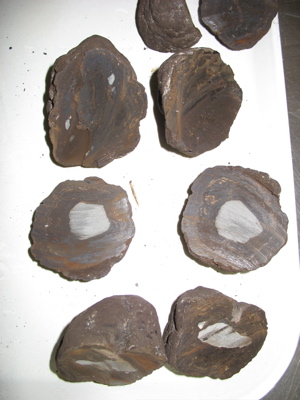Look at this beautiful day in the Scotia Sea!
 The sun was shining, the temperature rose, and the winds died down—what a wonderful day!
The sun was shining, the temperature rose, and the winds died down—what a wonderful day!
Okay, I really didn't get sunburned, but with few clouds and no wind the sun was an excellent feeling on my face!
First, let me give you the news on the dredge from late last night. Just as I was headed to my cabin we discovered that the dredge was stuck on the seafloor. The captain had to move the ship around for a couple of hours until the dredge finally dislodged from whatever has holding it. This morning, I was informed that the dredge brought up many rocks. Some of the rocks were tossed back into the sea because they did not relate to our research, but 2 main types were kept for further investigation. Tina was excited about these black rounded rocks called Ferromanganese nodules. They are mainly made of iron and manganese.
 Each nodule was cut in half using a rock saw. Look closely at the internal ring-shaped marks.
Each nodule was cut in half using a rock saw. Look closely at the internal ring-shaped marks.
These rings are actually individual growth layers. Each growth layer represents a different time period and Tina uses geochemistry to extract the seawater composition for that specific time period, and remember these rocks could date back 20- 40 million years. These rings are similar to tree-growth rings-the same idea.
The other type of rock found in the dredge was an igneous rock called an andesite, a volcanic chain rock. Julian, Alan, and Matt also used a rock saw to observe the inside of these rocks. They are continuing to investigate these rocks further, but they believe that these did originate in this area as part of the seafloor.
Later in the afternoon, we did another dredge, this time it was on a steeper slope. The dredge came on deck just at the start of dinner, but the dredge was full so dinner was postponed.
 The dredge was full of rocks ranging from big boulders to small drop stones.
The dredge was full of rocks ranging from big boulders to small drop stones.
Dredge #3 brought up more and bigger Ferromanganese nodules and andesitic rocks. Also, brought up were rocks that Julian called carbonate ooze. He can also use these to help confirm the age range of the seafloor. Look for photos of these rocks in the photo gallery. Almost immediately after the dredge was emptied it was sent down again for another dredge. The 4th dredge was at a depth of 467 meters when it had to be pulled back into the boat due to numerous icebergs "attacking the boat." The icebergs were not really attacking the ship, but there were too many around us to safely complete the dredge. Currently, we are traveling to the west and surveying the area for another possible dredge site. Everyone is very tired, but it was a very interesting and eventful day!

